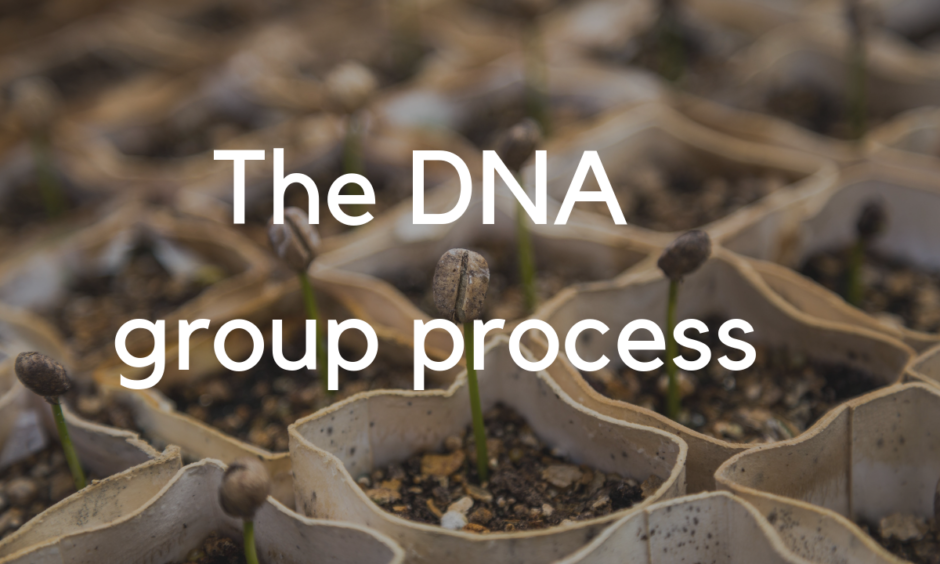DNA groups are a simple but very powerful discipleship process centered on opening the Bible with those who follow Jesus and those who don’t yet know Him. DNA stands for Discover, Nurture, and Act.
- Discover – we gather to discover God’s truth and to discover more about each other
- Nurture – we gather to nurture each other in our spiritual journeys
- Act – we gather to put into action what we learn together, obeying in response to what God reveals about himself and who we are and what we are to do.
Leading a DNA group is as simple as ABC:
Ask: A session sharing about life and praying together.
Bible: The Bible is at the center – disciples are empowered to discover the truth in God’s Word for themselves, rather than being taught by a leader.
Commit: Disciples commit to apply and share what they are learning.
Jesus discipled people in groups, and it is the best way to learn. A DNA group has the power of accountability and multiplication. DNA groups focus is on discipling pre-Christians by allowing them to discover God’s Word for themselves through the discovery Bible study process, rather than trying to get people ‘saved’ up front and then discipling them. It takes time; we are not in a hurry. In this process, we let people discover God’s story and His character. It is about re-shaping our worldview around God’s truth– to discover God’s story and our place in it.
A – Ask
Open by asking, “What are you thankful for this week?” It’s important to be specific. Rather than asking “How are you?” or “What has been good for you?” asking the question “What are you thankful for this week?”” guides people to articulate the good things that have happened. This becomes the basis for teaching them to praise and thank God.
Next ask, “What has been challenging in the past week?” This forms the basis of prayer for needs and opportunities to live out the “one another” commands in the New Testament. As you pray for needs, whatever they are, this makes space for God to break through and do the miraculous.
Thirdly, pray aloud together, thanking God for what was good, and praying for what is needed. Keep your prayers simple and to the point. Encourage others to pray as early as possible in the DNA process. Make your own prayers really simple so you don’t sound religious or ‘professional.’ This helps new disciples overcome the intimidation of learning how to pray. It’s important to teach people how to pray with others and out loud. It’s an important part of making a disciple.
Ask how they did with the previous week’s obedience steps and with their walk of discipleship with Jesus. Each week they will be sharing with someone (their family or friend) about what they have learnt. Ask how they did with this.
B – Bible
From the beginning the aim is to teach people to discover God’s Word for themselves rather than relying on a teacher. Disciples of Jesus understand that the Holy Spirit is sufficient. Self-discovered truth will stay with the person. Jesus used this approach often in his discipleship. He asked his followers, “Who do men say that I am?” and “Who do you say that I am?” affirming them, “Well done, flesh and blood has not revealed this to you, but my Father in heaven.” Jesus didn’t just tell them the answer. He didn’t just say from the beginning, “Hey guys, I am the Messiah, the Son of the living God!” Instead, he let the process of discovery happen over time by revelation from his Father. This is the same process used in the this Discovery Bible Study method.
Start by choosing a passage of Scripture that is simple, not too long and to the point. A story or narrative is good. Several possible lesson plans are included below; you may use them as a starting point or adapt them to suit your context. The suggestions listed below are long passages – the idea is to select a smaller passage out of these chapters. So for the first lesson, for example, you might focus on Genesis 1:26–28.
Read the Scripture. If the person is bilingual, read it aloud in their language then reread it in English. If they are not bilingual, it is good to read it and then re-read it. Then retell the story. This is important as it cements the story in our minds. Re-tell the story as you would tell it to a friend. The retelling of the story should be a group affair. One person can attempt to re-tell the story, and others can chip in and add to the picture. In this way the story is painted by the group.
Next, discuss the story.The key is for the leader (you) not to jump in too quickly and teach! Let them think and talk. What do they see in Scripture? If they ask you to explain, turn it around by asking, “What do you think?” Don’t be afraid of awkward silences. Sometimes it is good to simply be quiet, and let them come up with the answers. This can be to do since we are used to providing all the answers, but it is vital to this process. The leader’s job is to give space for each person to learn and to put what they see in their own words. Trust the Holy Spirit!
Ask questions like, “What does this say about God?” “What does this say about us?” “Are there areas you are bothered by?” “What do you like?” “What needs to be understood or obeyed from this passage?” If you are talking more than others in the group, then you are talking too much. Help the group stay centred on the Scripture. Encourage people with more biblical knowledge to not jump outside of the current text. Or if the person is sharing something that seems a bit “off”, bring them back to the text by asking “Where do you see that in this passage?” This will help train people that disciples of Jesus learn from His word rather than chasing their own ideas.
C – Commit to Obey
The final key to is to ground the discussion in obedience steps. Jesus described making disciples as “teaching people to obey everything I have commanded you.” We often miss the word ‘obey.’ Our discipleship processes are often knowledge-based and not obedience/action based. Whenever we learn from God’s word it should lead us to responding in obedience.
Start with giving people a moment to think and listen to the Holy Spirit. Then ask the question, “So what will you do about this?” Their response forms the basis of their obedience step. Let the person come up with their own commitment. It might be something like, “I need to respect people” or, “I need to be thankful.” Or it may be something very specific like, “I need to stop shouting at my kids!” Encourage the group to move towards SMART obedience steps (Specific, Measureable, Actionable, Realistic, Time-Bound). Whatever they feel led to do, it should to be listened to and respected. It is ok if it is a simple application. When someone commits to obey, truth that has come via Scripture and revelation becomes lived, personal and owned.
The last step is to ask the disciple to share with someone about what they have learnt this week. Talk with the person about who they are going to share with. Help them to overcome any barriers that might stop them sharing the good news with their family and friends. This weekly challenge ensures that sharing and multiplication are built into discipleship from day one. Even before they commit to follow Jesus, they start spreading what they are learning.
DNA Group Process Overview






No Comments